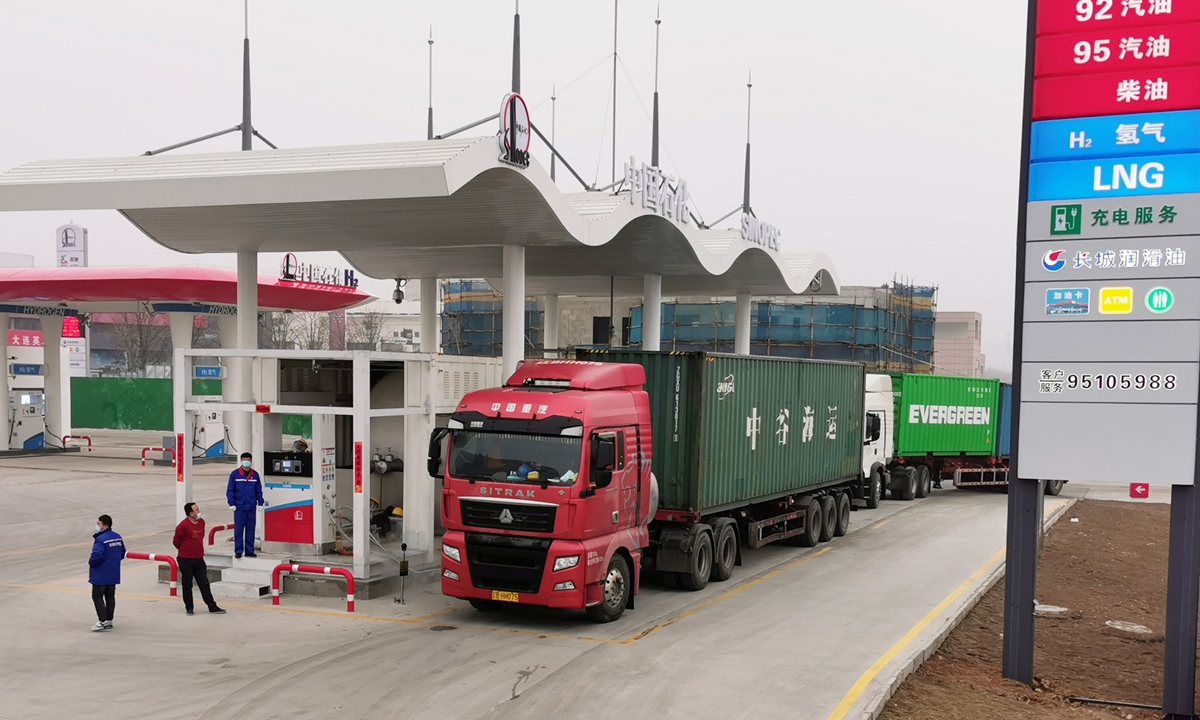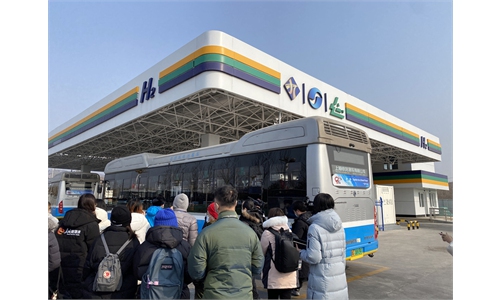China sets path for hydrogen sector as it targets green development
Nation's top planner sets path for hydrogen sector as it targets green development

A truck parks inside a new fuel station that provides refills and recharges for a wide variety of energy sources. The station, opened by state-owned oil major Sinopec in Dalian, Northeast China's Liaoning Province Sunday, is first of its kind in the region. It provides hydrogen refilling, electricity charging and natural gas refilling, in addition to gasoline, as China diversifies toward a greener energy mix. Photo: VCG
China's top economic planner, the National Development and Reform Commission (NDRC), on Wednesday issued a medium- and long-term plan for the development of hydrogen energy (2021-2035), setting a clear path for hydrogen's role in the country's acceleration toward green development and independence of energy supply.The plan, jointly launched by the NDRC and the National Energy Administration, defines hydrogen energy as a key strategic emerging industry and a new growth point for building and upgrading a green, low-carbon industrial system.
By 2025, a group of hydrogenation stations will be deployed, and hydrogen production from renewable energy will reach 100,000-200,000 tons per year. Carbon dioxide reductions will reach 1-2 million tons per year.
By 2035, a diversified application ecosystem of hydrogen energy will be formed, and the proportion of hydrogen production from renewable energy in terminal energy consumption will increase significantly, according to the plan.
Lin Boqiang, director of the China Center for Energy Economics Research at Xiamen University, told the Global Times on Wednesday that the plans for hydrogen power will further boost the domestic development of wind and solar, making the two new-energy sources a more stable source of supply.
As an energy-storage medium, hydrogen has a higher energy density than lithium battery energy storage, and can realize long-term energy storage at a lower cost than chemical energy storage.
Given this context, making hydrogen in western China where there is a massive amount of affordable electricity from wind and solar, and then transporting hydrogen to the eastern part of the country, would be an additional route to the current singular reliance on ultra-voltage power transmission lines, Lin said, noting that the current hydrogen-making process in east China is only transitional.
China has succeeded in the application of hydrogen refueling stations and fuel cell vehicles.
A recent example was the 2022 Winter Olympics in Beijing, when more than 1,000 fuel cell vehicles and up to 20 hydrogen refueling stations in the Beijing and Zhangjiakou competition areas were operated, providing clean and cost-effective transportation.
Fuel cell vehicles are only one of many breakthroughs in the application of hydrogen energy.
Lin said that long-term development should gradually expand to multiple applications in transportation, electric power, the chemical industry, metallurgy and other fields, and give full play to hydrogen energy in the nation's green and low-carbon transformation.
Experts said that China has the biggest potential to reach the target, given that it is the largest hydrogen producer in the world, with an annual output of about 33 million tons. Of this, about 12 million tons meet the industrial hydrogen quality standard, data from the NDRC showed.
China's installed capacity of renewable energy now ranks first in the world, a reflection of the great potential for clean and low-carbon hydrogen energy supply.
The China Hydrogen Alliance predicts that by 2025, the value of China's hydrogen energy industry will reach 1 trillion yuan ($157 billion), and by 2030, China's demand for hydrogen will reach 35 million tons, accounting for at least 5 percent of China's terminal energy system.
By 2050, hydrogen energy will account for more than 10 percent of China's energy system, and the annual value of the industrial chain will reach 12 trillion yuan.



